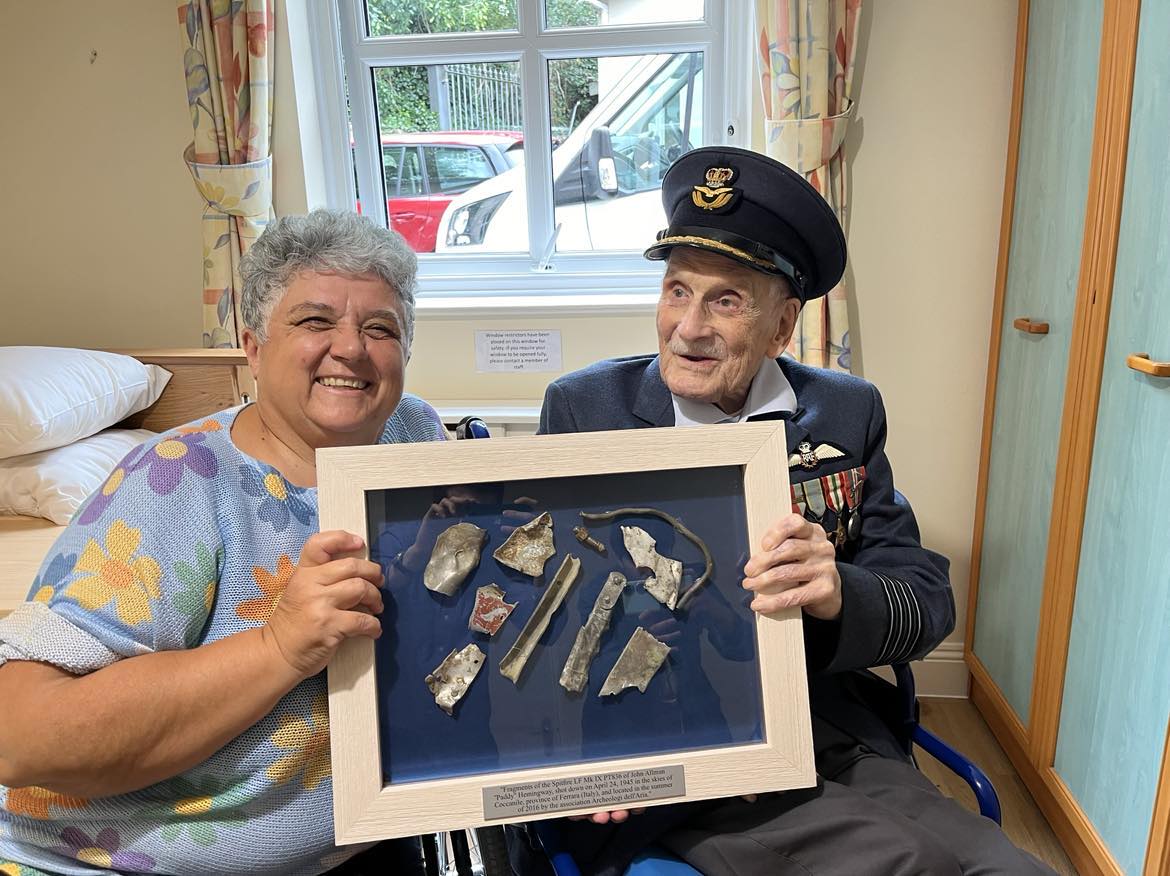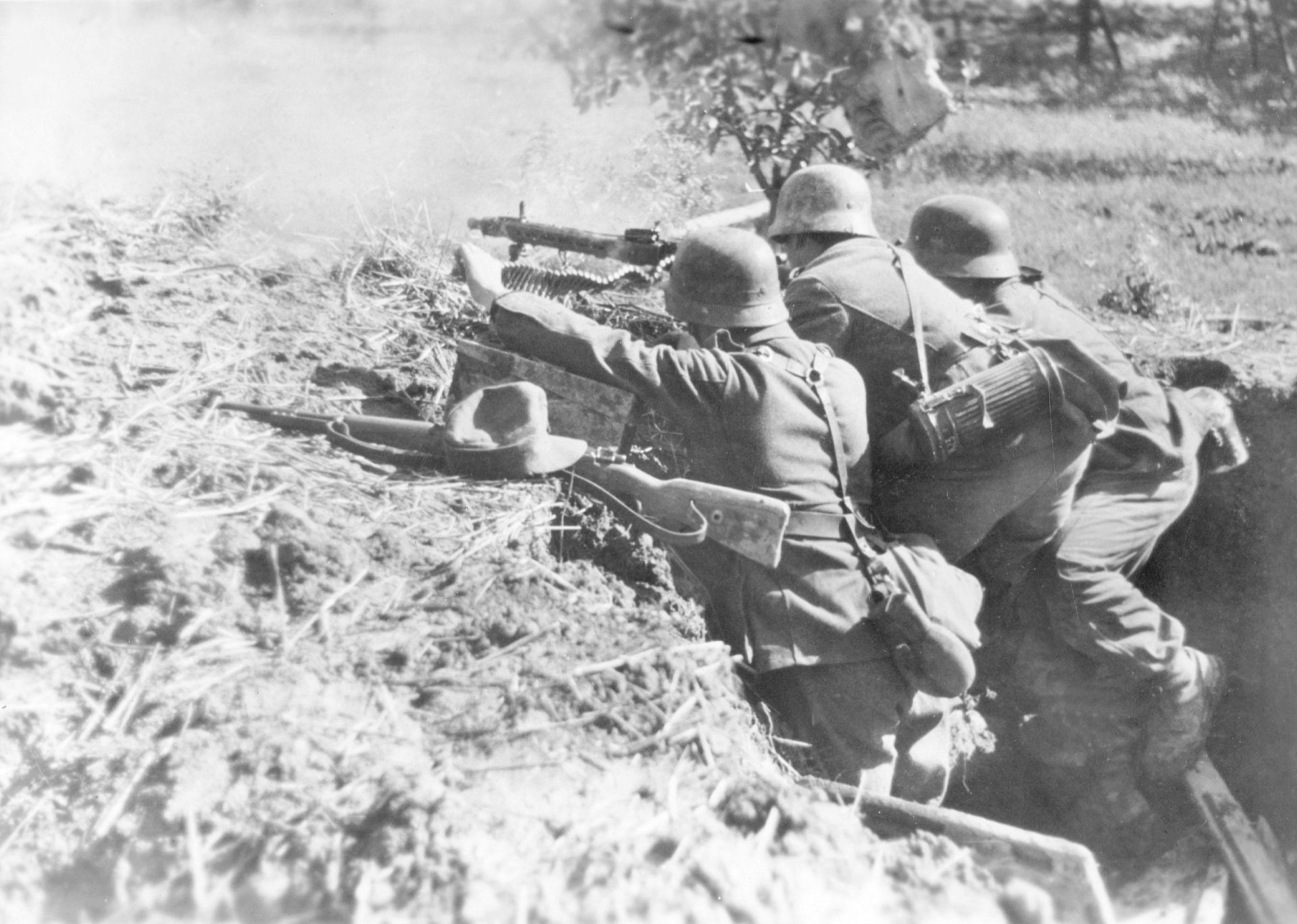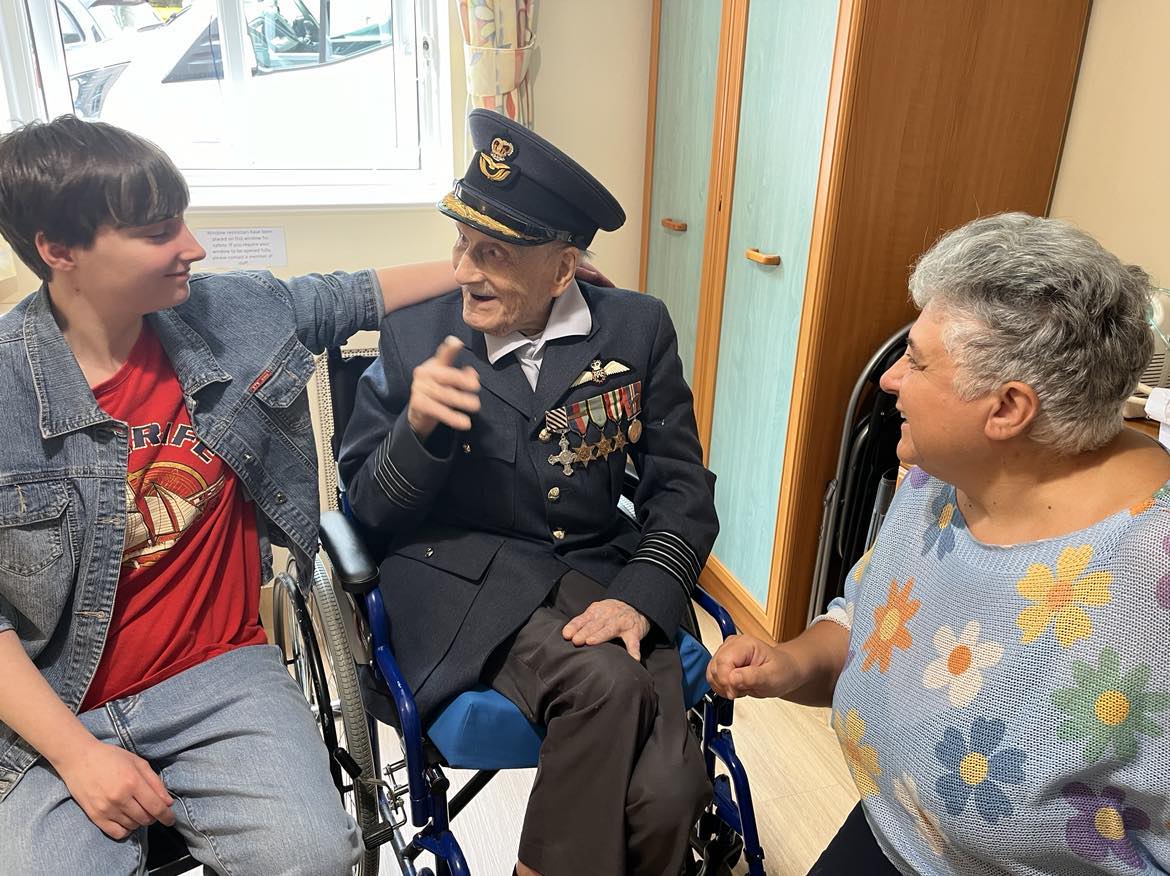An Irish World War II veteran has been reunited with the Italian family who helped him escape the Nazis from behind enemy lines in 1945.
Group Captain John Hemingway spent the war as a fighter pilot in the British Royal Air Force and was dramatically shot down in the final weeks of the war.
Unarmed and alone, had he been caught by the Nazis, he would almost certainly been shot dead.
He owes his survival to the bravery of a young Italian girl who led him to safety in one of the most extraordinary acts of courage in a conflict not short of acts of heroism.
Now 105 and living at a nursing home in Foxrock in South Dublin, Mr Hemingway was reunited in June with the the young girl's family after a gap of 79 years.
For Lina Volpi, the young girl's daughter, it was an emotional day and the pair chatted and reminisced, about their families, about the war and about all that had happened in the many years since.
Although they had never met before and spoke only a little of the same language – they still shared a profound connection.
It is one built on family and a daring story of bravery at a time when so much of Europe was under the boot of Nazi tyranny.
Today I had the enormous privilege of spending time with John ‘Paddy’ Hemingway DFC, 102 yrs old and the last of Churchill’s Few. It was humbling to hear this hero of the Battle of Britain tell his incredible story so modestly. @RoyalAirForce pic.twitter.com/3ldsUEab61
— ACM Sir Rich Knighton (@ChiefofAirStaff) October 6, 2021
The story begins in the final weeks of the Second World War.
At this point, it would be fair to say Dubliner John Hemingway had already experienced more than his fair share of warfare and danger.
Shot down three times alone in 1940, he might have been forgiven for wanting to sit out and rest of the war in the comfort of an office, carrying out desk duties.
Instead, Mr Hemingway remained eager to fly combat missions and in 1945, he was deployed to Italy.
By April that year, German forces were in disarray all over Europe but many Nazis were desperate to fight on and avoid the supreme humiliation of Germany losing a second World War.
On April 23rd, Mr Hemingway was flying 3,000 feet over the village of Coccanile when his Spitfire was hit by a barrage of gunfire.
As the plane hurtled towards earth, Mr Hemingway bailed out, his parachute opened and he descended safely onto the ground.
It was a dangerous place for an Allied airman to find himself. The area was teeming with Nazis and Mr Hemingway was all too aware they would happily shoot him, given half a chance.
Spotted by local farmers, he was pulled into a ditch and given worker’s clothes. As he was changing out of his uniform, he heard a panicked voice shouting and, although Mr Hemingway spoke no Italian, he recognised the sound of danger and fled.
Moments later two German soldiers appeared and the sound of gunfire rang out.
The last known Battle of Britain pilot, Gp Capt John ‘Paddy’ Hemingway DFC celebrated his 105th birthday at the @BritEmbDublin with the unveiling of portraits reflecting different stages in his life, painted by artist Dan Llywelyn Hall.
Full story: https://t.co/DPMYXPbsnf pic.twitter.com/GQGHSCH8Pw
— Royal Air Force (@RoyalAirForce) July 18, 2024
Still in dreadful pain from his crash landing, Mr Hemingway eventually decided to risk his life once again and ask for help at a local farmhouse.
“Me English,” he pleaded when the door opened. The family took pity on him and hid him away with a bottle of wine and some chicken.
The following day, Mr Hemingway was taken to another farmhouse where his fate was discussed in typical Italian fashion, with plenty of passionate gesticulation.
In the end it was agreed. Carla, the family's young child, would lead him to safety. Dressed like a local, with a young girl for company, who could possibly mistake him for an Allied airman?
It was a dangerous plan but also the best hope of returning the airman safely to the comrades.
Carla took Mr Hemingway by the hand and the pair set off in a southerly direction.
It was a terrifying ordeal for the young pilot. As they walked past Nazi troops dug into trenches, Mr Hemingway was petrified his true identity would be discovered and the little girl holding his hand would be cruelly punished.
A Very Happy 101st Birthday to Grp/Cpt. John 'Paddy' Hemingway, who flew with No.85 Squadron, during the Battle of Britain.
'Paddy' is the last 'known' member of 'The Few'
Please join us in wishing the very special and amazing man a Very Happy Birthday. pic.twitter.com/wrXREwCPvY
— Battle of Britain (@MuseumKent) July 17, 2020
He needn’t have worried. The Germans had more important things on their minds than a local man and child out for a casual stroll together.
Eventually, they made it to another farmhouse and Carla, her mission completed, bade him farewell and disappeared. The pair never met again.
Mr Hemingway was handed over to the Italian Resistance who in turn reunited him with an advance column of the British Army. As he reflected years later in an interview for the RAF, it was “another lucky escape” but one that had left “a deep, indelible mark on my character”.
Just hours afterwards, the young pilot was back in the air again flying once again.
Days later, Hitler died by suicide and Germany surrendered. The war was over and Mr Hemingway and his comrades had won.
Today marks the 74th anniversary of #LiberationDay, an ?? national holiday, also known as “Festa della liberazione d'Italia”. The day celebrates the end of the fascist regime and of the Nazi occupation of #Italy #FestadellaLiberazione pic.twitter.com/atETT54UEa
— Italy in UK (@ItalyinUK) April 25, 2019
Decades later, an Italian woman named Lina Volpi returned home from a day of work and flicked on the television. There was a report on the news about Group Captain John Hemingway, an Allied airman who had crashed in Italy in 1945.
He was then 104 and back living in his home city of Dublin. He was hoping to reunite with the little girl who had helped all those years ago - did anyone in Italy know her?
Instantly, Ms Volpi knew who the little girl was - it was her mother, Carla Fabbri, who had passed away 10 years ago.
Growing up, other children were told tales about Hansel and Gretel or Little Red Riding Hood before bed. Ms Volpi’s mother preferred to tell her about the handsome young airman who had crashed from the sky one day and then cunningly escaped the Nazis.
To the Fabbri family, Mr Hemingway was a hero no fairytale prince could compare with.
“It was the most wonderful story,” Ms Volpi said.
Emails were exchanged and flights were booked for Ms Volpi and her daughter, Lidia.
On a grey Dublin day, the pair arrived at Mr Hemingway’s nursing home in Foxrock and were ushered into his room by his son Brian and an Italian translator.
Upon catching sight of the centenarian dressed smartly in his RAF uniform and medals, Ms Volpi let out a ‘wow’ of excitement and moved forward to embrace him.
“In this moment, I have met a big person who met my mother,” Ms Volpi said, her voice choked with emotion.
“I feel my mother here.”
Among the gifts she brought with her was a framed display of fragments of the Spitfire he was shot down in, which was carefully excavated by the local Association of Archeology in 2016.
Typically well-mannered, Mr Hemingway described it all as “marvellous” but insisted, “The best souvenir is yourself.”
When asked about his health, he quipped, “I’m almost too well.”
 Lina Volpi and John Hemingway.
Lina Volpi and John Hemingway.After pouring over pictures of the crash site and Carla Fabbri at various stages in her life, Mr Hemingway then showed her his medals. As befitting an airman with several decades of service behind him, he has many medals - including a Distinguished Flying Cross presented to him by the British monarch for bravery after the Battle of Britain.
For Ms Volpi, however, the most important honour in his collection is the gold star that hangs from a green, white and red cloth - the Italy Star that was presented to British and Commonwealth veterans who helped liberate her country.
“Italia - for the Italian campaign,” she exclaimed proudly.
During the Second World War, an estimated 200,000 Italians worked at for the Resistance.
For some, it meant joining partisan groups that fought the Nazis, for others it meant secretly distributing anti-fascist propaganda. All of it was dangerous work and around 70,000 Italians were killed by the Nazis and their fascist allies for Resistance work.
 German soldiers on the front in Italy, 1944. Picture by: Alamy.com
German soldiers on the front in Italy, 1944. Picture by: Alamy.comChildren were often murdered as well - even if they were entirely uninvolved and ignorant of Resistance activities.
In August 1944, in the Tuscan hills of Sant'Anna di Stazzema, the SS 16th Division killed 560 civilians of whom around 130 were children. It was all part of a scorched earth policy as the panicked Nazis retreated northwards from the encroaching Allies.
Even in wartime, when communications were disrupted and censored, such stories spread across the Italian countryside like wildfire, fuelling hatred of the Nais and a desire to resist them in any way possible.
Despite the stakes being a matter of life or death, Ms Volpi said her family believed strongly that helping a young Allied airman was the “normal” thing to do. Her mother was, she asserted, a “big [courageous] woman all her life”.
“They didn’t think about the risk, they were just thinking about helping one man,” she said.
Clearly, even as a child, Carla was quite the character and Mr Hemingway modestly insisted, “I just did as I was told.”
“She would be happy to have helped John to escape and save him,” Ms Volpi said.
 Lidia, John and Lina.
Lidia, John and Lina.After several hours of catching up, Mr Hemingway and the Volpis parted - but after 79 years apart, it seems unlikely it will be so long again before the families meet again.
“This is my first time [in Ireland] - but not the last,” Ms Volpi said smiling.
Every day, the number of veterans from the Second World War veterans dwindles further.
In Ireland they likely number in single figures. Yet, the stories of those men and women linger on.
Most of history is not made up of the actions of statesmen and women - important though they are - but the actions of ordinary men and women who did extraordinary things in the most challenging of times
Sometimes, as in the case of Carla Fabbri, it is the brave actions of a child risking her life to help a lost Irishman battling for the freedom of Italy that echoes through history.
Main image: Lina Volpi and John Hemingway. Picture by: Newstalk.









